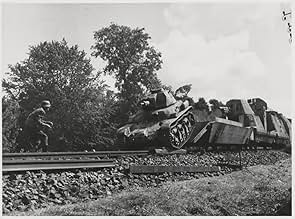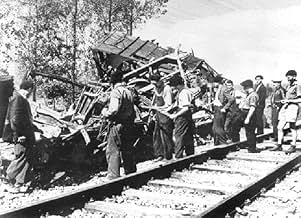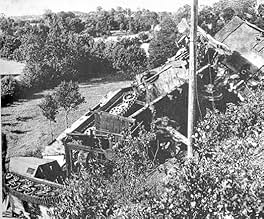IMDb RATING
7.0/10
1.4K
YOUR RATING
Recounts the courageous efforts by French railroad workers who were part of an organized resistance during German World War II occupation.Recounts the courageous efforts by French railroad workers who were part of an organized resistance during German World War II occupation.Recounts the courageous efforts by French railroad workers who were part of an organized resistance during German World War II occupation.
- Awards
- 3 wins & 1 nomination total
Marcel Barnault
- Cheminot
- (as Barnault)
Jean Clarieux
- Lampin
- (as Clarieux)
Jean Daurand
- Cheminot
- (as Daurand)
Lucien Desagneaux
- Athos
- (as Desagneaux)
François Joux
- Cheminot
- (as Joux)
Pierre Latour
- Cheminot
- (as Latour)
Robert Le Ray
- Chef de gare
- (as Leray)
Pierre Lozach
- Cheminot
- (as Lozach)
Pierre Mindaist
- Cheminot
- (as Mindaist)
Léon Pauléon
- Chef de gare St-André
- (as Pauleon)
Fernand Rauzéna
- Cheminot
- (as Rauzena)
Michel Salina
- Allemand
- (as Salina)
Charles Boyer
- Narrator
- (voice)
- (uncredited)
- Director
- Writers
- All cast & crew
- Production, box office & more at IMDbPro
Featured review
Although there have been more nuanced, psychologically penetrating filmic depictions of French resistance under Nazi occupation, none has matched the sheer immediacy of René Clément's feature film debut. It represents a natural progression from his pre-war documentaries and indeed the early part is filmed in a documentary style with no clear delineation of character but changes tack dramatically when news comes through of the Allied landings and the Maquis plan greater acts of sabotage to prevent the Germans from moving armoured trains to Normandy.
Based upon real events and featuring many of the courageous participants in the Battle of the Rails of 1944, Clément uses cinéma vérité techniques and Russian-style montage to build momentum and suspense, culminating in the unforgettable derailment of the train convey which is shot from three different angles. Suffice to say the film's most powerful scene is the execution by firing squad of six randomly chosen railway workers. This is a superlative combination of image and sound as their deaths are accompanied by trains whistling in defiance. The post-sync dubbing of the mainly non-professional cast is pretty good and this viewer at any rate is intrigued as to who supplied the German voices. Clément has also been sure to use the strongest, most characterful faces for the close-ups.
It seems that the French suffered from collective amnesia following the liberation and Clément made a brave call for his film might have come too soon and been too close to home but its triumphalism ensured its great critical and commercial success whilst arguably paving the way for Alexander Esway's hugely popular 'Le Bataillon du Ciel' the following year. One cannot help but wonder whether John Frankenheimer was aware of this film when making 'The Train' twenty years on.
As well as being a moving testament to the kind of bravery of which very few are capable it marks, on a purely filmic level, the emergence of a special directorial talent that was to go from strength to strength.
Based upon real events and featuring many of the courageous participants in the Battle of the Rails of 1944, Clément uses cinéma vérité techniques and Russian-style montage to build momentum and suspense, culminating in the unforgettable derailment of the train convey which is shot from three different angles. Suffice to say the film's most powerful scene is the execution by firing squad of six randomly chosen railway workers. This is a superlative combination of image and sound as their deaths are accompanied by trains whistling in defiance. The post-sync dubbing of the mainly non-professional cast is pretty good and this viewer at any rate is intrigued as to who supplied the German voices. Clément has also been sure to use the strongest, most characterful faces for the close-ups.
It seems that the French suffered from collective amnesia following the liberation and Clément made a brave call for his film might have come too soon and been too close to home but its triumphalism ensured its great critical and commercial success whilst arguably paving the way for Alexander Esway's hugely popular 'Le Bataillon du Ciel' the following year. One cannot help but wonder whether John Frankenheimer was aware of this film when making 'The Train' twenty years on.
As well as being a moving testament to the kind of bravery of which very few are capable it marks, on a purely filmic level, the emergence of a special directorial talent that was to go from strength to strength.
- brogmiller
- Oct 26, 2023
- Permalink
Storyline
Did you know
- TriviaIn part financed by what had been the Resistance as a way of showing international audiences what the French population had been facing under Nazi oppression. The Resistance was also keen to let the world know that they had been actively involved in disrupting the German war machine in France as the international perception at the time was that the French had capitulated and collaborated a little too easily with their Nazi captors.
- GoofsRailway worker tapping Morse code just repeats letter "V" most of the time with only a few exceptions.
- Crazy credits(in cast) et Les cheminots de France
- ConnectionsFeatured in Cannes... les 400 coups (1997)
- How long is The Battle of the Rails?Powered by Alexa
Details
- Release date
- Country of origin
- Official site
- Languages
- Also known as
- Bitka za prugu
- Filming locations
- Gare SNCF, Saint-Brieuc, Côtes-d'Armor, France(first scenes, train station)
- Production companies
- See more company credits at IMDbPro
- Runtime1 hour 25 minutes
- Color
- Sound mix
- Aspect ratio
- 1.37 : 1
Contribute to this page
Suggest an edit or add missing content

Top Gap
By what name was The Battle of the Rails (1946) officially released in Canada in English?
Answer



















